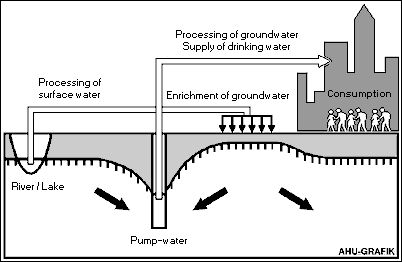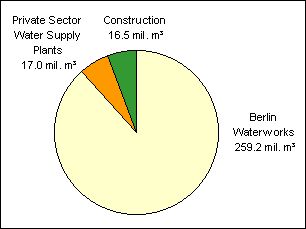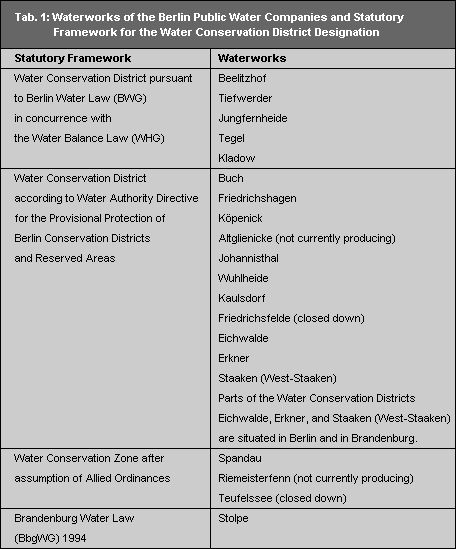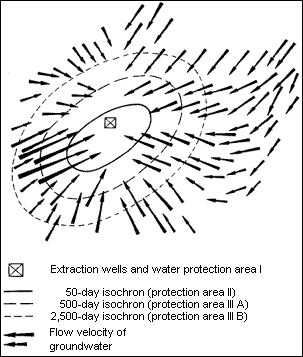Use limitations within conservation districts were supplemented and extended in the course of revising the Water Conservation District Regulations according to the isochronic concept.
East Berlin
Water conservation districts in East Berlin were defined under GDR law. The legal basis is the Water Law of the GDR in its 3rd Implementation Ordinance (Durchführungsverordnung) of 2 July 1982 in regard to conservation and reserved areas. The East Berlin conservation districts were enacted at the 14th Berlin city council meeting on 19 October 1984.
The GDR determined reserved areas for future water supply production, where no groundwater was withdrawn. Special use limits were in force in these areas, as given in the Water Law of the GDR or in TGL 43271 of September 1984.
The border between West Berlin and the GDR was an unnatural border in the definition of water conservation districts and against the given geological and morphological conditions of the area. Conservation districts were forced to end at the political border. The new definition of drinking water conservation districts can finally resolve this problem properly.
The 5 waterworks located in the eastern part of Berlin will be protected until a final new definition of water conservation districts is made according to Federal German law by 1999. This protection takes place under Berlin Water Law by a directive of the Water Authority Directive for the Provisional Protection of Berlin Conservation Districts or Reserved Areas of the Waterworks, dated 11 October 1993, latest revision 27 February 1996. Use restrictions under this directive are similar.
Water conservation districts in the surrounding areas of Berlin are defined according to GDR law. New demarcations and changes of conservation districts, as well as changes in protective status or area size are to occur after the passage of drinking water conservation district ordinances for each waterwork according to the Water Law of the State of Brandenburg. An ordinance determining the water conservation district for the Stolpe Waterwork in Brandenburg is being prepared according to the Brandenburg Water Law (Brandenburger Wassergesetz – BbgWG) of 13 July 1994.
Use Restrictions in Water Conservation Districts
Water conservation districts have protective zone categories with differentiated use restrictions.
Conservation Zone I prohibits all activities except for those measures required for water supply purposes.
Conservation Zone II prohibits:
- the erection or alteration of constructed facilities (residential buildings, industrial facilities, streets) with the exception of alterations in buildings
- the erection and operation of facilities for dealing with substances harmful to water and the transportation of substances harmful to water through pipelines;
- the discharge of waste water and non-purified rain water into surface waters;
- the use of fertilizers, insecticides, herbicides and pesticides;
- the removal of water and solid materials from the subsoil and from openings in the earth.
Conservation Zone III prohibits:
- the discharge of waste water into the subsoil with the exception of the spraying or seepage of rain water through the topsoil;
- activities which enable the penetration of pollutants into surface waters, the subsoil or groundwater; in particular the dismantling and repair of motor vehicles, including the changing of oil on unstabilized soil;
- the erection, rebuilding, extension or basic alteration of buildings, unless there is a complete and proper waste water drainage by sealed pipelines into public waste water facilities, or the collection of drainage in permanently sealed pits with proper disposal;
- the erection and operation of dumps for waste harmful to water and/or waste disposal facilities which require planning approval;
- the construction of gravel pits, the placement and storage of materials harmful to water directly on the subsoil, particularly for the construction of streets, canals, and paths; with the exception of small improvements with no danger of contamination;
- the construction or extension of drains for dewatering the subsoil.
The protective regulations of Conservation Zone III apply to the narrow Conservation Zone II and for the captation area (Zone I). The protective regulations for the narrow Conservation Zone II apply to the captation area (Zone I).
The prohibitions of Conservation Zone III as well as two prohibitions of Conservation Zone II apply to the Plänterwald and Gosener Wiesen reserved areas. These areas are part of the conservation district of the Johannisthal Waterwork and/or the Friedrichshagen Waterwork.
There is also a number of smaller groundwater supply facilities in the private sector, usually for industrial purposes, or commissioned by public facilities. Water is withdrawn and treated in these private sector water supply plants by users themselves. These plants are usually established and run by industrial and commercial operations, but also by public institutions such as hospitals and swimming facilities. The groundwater they withdraw is used as drinking, operating, and cooling water, and to water plants, lawns and meadows. Both the Berlin Public Water Companies, private sector water supply plants require official permits or special approval with specified use considerations and restrictions. These are mandated by the Berlin Water Balance Law or the Berlin Water Law. There are no conservation zones for private sector plants.




